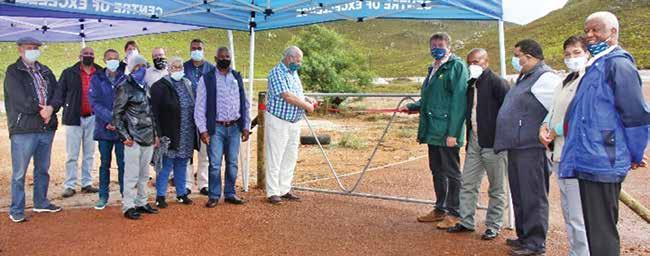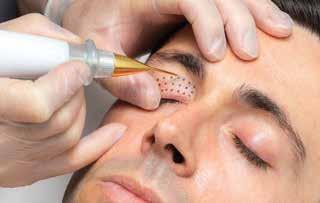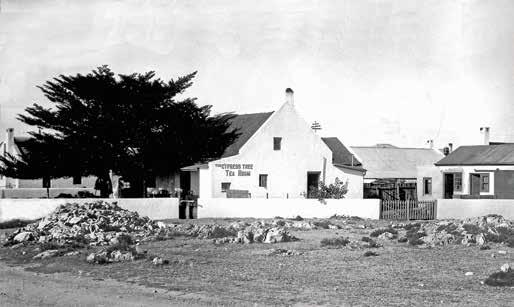4
www.thevillagenews.co.za
24 March 2021
Anina Lee and her wonderful world Writer Elaine Davie
I
t’s called evolution,” laughs biochemist turned conservationist Dr Anina Lee, describing the extraordinary adaptive strategies a multitude of life forms, from tardigrades to fynbos, have developed over millennia to ensure their survival. To followers of The Village NEWS, Anina will be no stranger. Week after week for four years she has unpacked a treasure trove of intriguing stories drawn directly from nature, making her one of our most popular contributors. Readers will therefore be excited to know that on Tuesday this week she launched a new book, consisting of 30 of her favourite essays, appropriately titled What a Wonderful World! An all-round local publication, it features detailed and lively watercolour Illustrations by Onrus artist, Margie Crossman and has been published by David Hilton-Barber’s Footprint Press. Not only will local readers have the pleasure of reading and re-reading the collection, or simply browsing through it to revel in the illustrations, but it will be the ideal gift for friends and family members further afield. While Anina makes no bones about its educational intent, it will be as much fun for adults as for children. Her easy, often humorous writing style clearly reflects Anina’s unflagging interest in her subjects. Although she has a PhD in Biochemistry, she never allows that to stand in the way of an almost child-like joy in the surprises she continues to unearth in nature. “Many of the adaptations both animals and plants have developed are geared towards protecting their proteins and DNA, like the protective chemicals excreted by frogs. As a biochemist, that really intrigues me, but the challenge is to explain the science in layman’s
And then who should come into her life but Margie Crossman, Chairperson of the Hermanus Art Circle, who was not only an artist, but also had a background in biology, which meant she had an understanding of the anatomy of things. It turned out to be a match made in heaven.
language – to get away from scientific jargon.” She quotes the brilliant scientist, Richard Feynman who she says expresses her feelings exactly: ‘I do science for the pleasure of finding things out’. “I usually know little or nothing about my topics beforehand and my greatest satisfaction is in doing the ‘finding out’, asking the questions my readers might want answered. I never stop being grateful to scientists who so generously share their knowledge and research results on the internet. If you have the time and the interest you can find almost anything there. “Half the fun is deciding on a topic and it sometimes takes me two to three days of reading widely, watching TV documentaries and generally thrashing around until suddenly a spark ignites an idea and I’m off.” Anina usually chooses topics that are relevant to the Western Cape and the Overberg in particular. Occasionally, though, she comes across something which is endemic to another part of the world entirely, but she finds so fascinating that she can’t resist writing about it, like the peacock spider from Australia. “A major challenge, though, is to keep the story short enough for the space available without losing content and then to make the language accessible enough for lay readers. My training in academic writing was clearly not going to cut it, so I am truly indebted to the two great newspapermen who retired to Hermanus, Harvey Tyson and Rex Gibson, for their guidance.”
Although this was her debut as an illustrator, she took to it like a duck to water and eventually produced roughly 100 illustrations, devoting approximately three days to each. The result is a portfolio of watercolours depicting subjects as varied as plants, birds, butterflies, wasps, frogs, chameleons, beetles, cicadas, spiders, octopuses and leopards.
Although she had been turning the idea of a book around in her mind for some time, the person who gave her the push she needed was Professor Mike Bruton, who suggested she get going and find a publisher. Which is what she did. Hermanus’s David Hilton-Barber agreed to take on the project for Footprint Press, and then she started casting around for an illustrator. “Although I generally use photographs in my articles, it was just going to be too difficult, time-consuming and expensive to obtain copyright permission for an entire book. So what I was looking for was an illustrator with a scientific background who could also reflect the spirit of the book.”
So enthusiastic was she about the project that she was prepared to work on it pro bono, but fortunately Anina was able to obtain a sponsorship from the AVI Community Trust in Gansbaai on condition that the book would be used for educational purposes. This was also able to cover an honorarium for Margie, albeit a fraction of what the paintings were worth. Now that the job is done, she has informed Anina that she feels at a loose end and needs her to begin working on another book! Anina bubbles with enthusiasm about each of the creatures she has written about. She clearly has a huge amount of respect for them and their will to survive. Her research extended way beyond the searches she carried out on the internet. “For example, when I was learning about the microscopic tardigrade,” she says, “I went hunting and actually found
some in mossy patches in Fernkloof. Now I have moss growing in a bottle at home to see if they will reproduce there. “One of the things I got particularly hot under the collar about was the hype that has grown up around the hoodia plant, which is alleged to facilitate weight loss. In fact most of it is absolute rubbish and there is little evidence that the commercial products claiming to contain hoodia, in fact do. People are so desperate to lose weight that they’ll believe anything.” In the role she plays at Whale Coast Conservation (WCC), Anina has been deeply involved in the Chameleon Rescue project and she has decided to donate R50 for every book sold to help cover the costs incurred. Although the team relies to a large extent on volunteers to assist with the rescue process, considerable costs are incurred in tracking, tracing, photographing and rehabilitating them. Get her started on that topic and it’s hard to stop her. So, when you buy the beautiful book which will bring you hours of pleasure, you will have the added satisfaction of knowing that it will assist a very special cause. Copies are available at R260 a copy directly from the publishers at footprintpress.co.za/shop/. A number of Margie Crossman’s original paintings are also for sale at R800 each. They can be seen in a digital brochure on the FynArts website, www. hermanusfynarts.co.za and purchased by emailing admin@fynarts. co.za or at the FynArts Gallery in the Harbour Road Courtyard. Anina will also be giving an illustrated zoom talk on the book on Thursday 25th at 18:00. If you would like to participate please contact her at anina.wcc@gmail. com for a link.




















